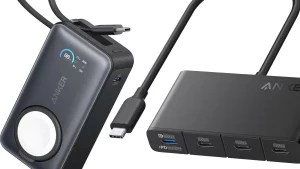Some Key Words on Keyboards

I’m willing to bet you don’t give your computer’s keyboard much thought (beyond the occasional cleaning of all those muffin crumbs). Typing is so second nature to most people, they probably don’t stop to think, “Why are keyboards arranged this way?”
That’s a good question, especially as we move farther away from physical keyboards.
The History of QWERTY
There are a lot of myths surrounding the development of the QWERTY keyboard. The most common story goes like this: Christopher Latham Sholes, a printer and newspaper man in Milwaukee, WI, wanted to make his business more efficient, so he developed an early version of the typewriter in 1868. This 28-key version arranged everything alphabetically, because, why wouldn’t you? It was thought to be easiest and most familiar way to arrange the keys, resulting in the least amount of hunting and pecking.
The most common theory explains that Sholes moved away from this arrangement because of mechanical failings. If typed on too quickly, the mechanisms would get jammed. The QWERTY keyboard was supposedly designed to separate common sequences of letters to slow typists down, and reduce the number of malfunctions.
By 1878, Sholes was issued a U.S. Patent with the first documented appearance of the QWERTY layout, entered into a business arrangement with gun-maker Remington the same year, and by 1890, sold more than 100,000 QWERTY-based typewriters across the country.
There’s another theory that basically boils down to the monetization of the proprietary system: Along with selling typewriters, the company also sold training courses, creating brand loyalty and QWERTY-trained typists.
Other keyboard arrangements have been developed since (the Dvorak Simplified Keyboard, for example), but the prevalence of QWERTY since its inception 140 years ago has remained beyond its mechanical necessity.
Keyboards Today
Through the advent of personal computers, laptops, mobile phones, tablets, and more, the QWERTY keyboard remains. Even though we interact with it differently (texting with one hand, say, or typing with your thumbs) the familiar pattern is still there.
Even so, the next wave of college graduates set to join the workforce were raised with touch devices, and as those new workers replace those who are retiring, the reliance on physical keyboards may see a shift.
So is QWERTY going to die out? Probably not (right away).
In a recent report on consumer trends, the sales of tablets are trending down, but the market for 2-in-1 laptops (tablets with detachable keyboards) is expected to grow at 21.2%, suggesting the desire for a typing device is still strong.
Still, that mechanical keyboard might eventually become obsolete. The technology developing around touchscreen keyboards (and maybe even VR keyboards) is getting better all the time, with the use of next-generation haptics to simulate the experience of typing on a physical, push-button keyboard. Other developments in technologies such as AI and voice recognition may also lessen the need for physical keyboards.
Any maybe, as this article suggests, for technology to truly take the next big leap, we need to rethink the way we interact with computers – through a keyboard, mouse, or touch screen – all together.
via GIPHY
Either way, if you’re still able to drop it, we’ll still try to fix it. ?










